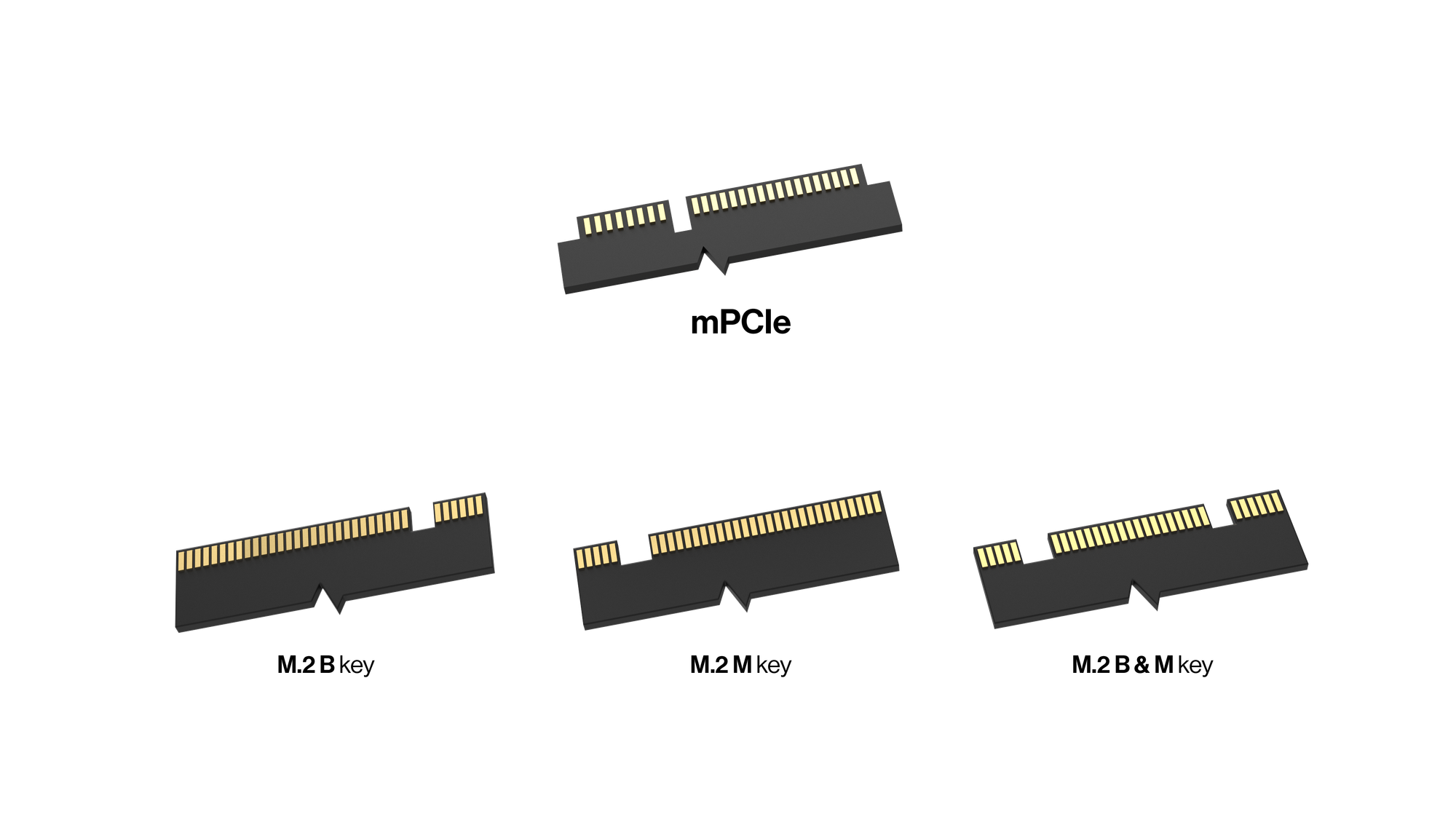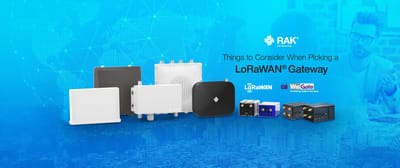Bridging Connectivity Gaps: The WisLink M.2 Concentrator Module for LoRaWAN® (RAK5166/RAK5167)
In an increasingly connected world, the demand for seamless integration and communication between devices is paramount, especially in industrial settings. The RAK5166/RAK5167 WisLink M.2 LoRaWAN module emerges as a pivotal solution, crafted to address the rising need for a versatile and efficient connectivity platform in these environments.
Why RAK5166/RAK5167?
The introduction of the RAK5166 and RAK5167 modules is a strategic response to the evolving demands in the hardware manufacturing sector, particularly the shift towards the M.2 form factor in industrial PCs, routers, and IoT gateways. This transition is driven by the need for more compact, versatile, and powerful devices across various industries. On the other hand, LoRaWAN's long-range and low-power communication traits are essential, particularly in sectors like manufacturing, transportation, and building management where expansive and energy-efficient coverage is crucial. So, why not combine M.2 form factor with LoRaWAN connectivity?
Adapting to Market Trends
The shift to M.2 by hardware manufacturers isn't just a preference—it's a necessity born from the demands for greater efficiency and modular flexibility in device design. The M.2 form factor is becoming prevalent due to its compact size and enhanced capabilities, making it an essential feature in new-generation industrial and IoT devices. However, as these devices evolve, there remains a significant need for them to maintain robust connectivity options, including LoRaWAN, which is crucial for a wide range of IoT applications.
Bridging Connectivity with Modern Form Factors
While LoRaWAN connectivity has been available through mPCIe concentrators, these do not align with the newer M.2 standards that are becoming commonplace in device design. The RAK5166 and RAK5167 WisLink concentrators fill this gap by offering LoRaWAN functionality in an M.2 format, ensuring that manufacturers can continue to leverage this essential communication technology without compromising on the modern form factors of their devices.
Enhancing Device Capability and Integration
The RAK5166 (Type 3042) and RAK5167 (Type 2280) not only align with the industry’s move towards more streamlined and compact devices but also enhance these devices' capabilities by integrating cutting-edge communication technology directly into their architecture. This integration supports a seamless and efficient connection to IoT networks, which is vital for applications such as smart cities, industrial automation, and remote asset management.
The Solution to a Real Need
Before the advent of the RAK5166/67, integrating LoRaWAN capabilities into existing systems was not only challenging but also sometimes impractical due to compatibility and space constraints. The concentrator module addresses these issues head-on with its M.2 form factor, aligning perfectly with the trend toward this configuration in industrial and embedded systems. We chose the 3042 and the 2280 types for this launch as they are the most versatile, following industrial trends. The module's compatibility with two standards (2280 and 3042) enhances its flexibility, allowing for seamless integration without additional modifications. This plug-and-play capability is critical for industrial PC manufacturers and IoT developers looking to upgrade existing systems with minimal disruption.
The innovation doesn’t stop at its form factor. The new WisLink concentrator modules are designed around the Semtech SX1303 processor, known for its efficiency and ability to handle multiple communication channels simultaneously — up to ten programmable parallel demodulation paths. This capacity ensures robust data handling, crucial for environments where numerous sensors and devices operate concurrently.
The development of the M.2 concentrator module was not just about technological advancement but also about providing practical, tangible solutions to the challenges faced by industries today. By converting traditional devices into powerful LoRaWAN gateways, the RAK5166/67 module facilitates a smarter, more interconnected ecosystem. This capability is invaluable in realizing the full potential of IoT applications, enhancing data-driven decision-making and operational efficiency across various sectors.
M.2 or mPCIe Form Factor?
The M.2 and mini PCI Express (mPCIe) are both standards for internally mounted expansion cards, or LoRaWAN concentrator modules in this specific case. They differ in several significant ways, which impact their suitability for different applications. Here's a detailed comparison:
|
Parameter |
M.2 |
mPCIe |
|
Form Factor and Size |
Originally known as the Next Generation Form Factor (NGFF), M.2 is more flexible in terms of physical size. It supports multiple widths and lengths, which include 22x80 mm and 30x42 mm. This variety allows for greater flexibility in the design of the host device. |
Mini PCI Express cards have a standardized size of about 30x50.95 mm. This makes them larger and less versatile in terms of motherboard layout compared to M.2 cards. |
|
Connector and Pin Configuration |
Uses an edge connector with different keying options that prevent incorrect insertions and define the module's capabilities (e.g., B key, M key, or B+M key), supporting interfaces such as PCIe, SATA, and USB. |
Uses a 52-pin card edge connector, typically only supporting PCIe and USB interfaces, limiting its versatility compared to M.2. |
|
Performance and Interface |
Can support up to four PCIe lanes, providing significantly higher data transfer rates, which is ideal for SSDs and other high-speed devices. It also supports other protocols like SATA for storage devices and USB for various other peripherals. |
Generally supports a single PCIe lane, which limits its data throughput compared to M.2. This makes it less suitable for applications that require high-speed data transfer. |
|
Applications |
Its versatility and ability to handle multiple interfaces make it suitable for a wide range of applications, including storage (both SATA and NVMe SSDs), wireless cards (Wi-Fi and Bluetooth), and cellular modems. Its small size and flexibility in terms of module size make it particularly well-suited for compact and portable devices like laptops and tablets. |
Predominantly used in applications where only a single PCIe lane is required. Common uses include network cards, small-scale SSDs, and interface expansion in industrial and embedded applications. |
|
Future-proofing |
The support for a broader range of interfaces and higher data rates, along with the ability to accommodate smaller and more diverse physical sizes, makes M.2 more future-proof. It's increasingly being adopted as the standard in newer laptops and motherboards. |
While still used, it is becoming less common in new consumer devices but remains in use in industrial and legacy systems where changing existing designs is less feasible. |

While both M.2 and mPCIe offer expansion capabilities, M.2's flexibility in size, support for multiple interfaces, and higher performance make it more suitable for a wider range of modern applications, especially in consumer electronics where space and speed are critical. Meanwhile, mPCIe remains relevant in specific contexts, particularly where only PCIe is required or in industrial and embedded systems.
Enhanced Connectivity with RAK5166 and RAK5167: Tailored LoRaWAN Solutions
The RAK5166 and RAK5167 modules are pivotal components in modern industrial and IoT systems, each tailored to meet specific integration and space requirements with their distinct M.2 form factors.
Both modules harness the power of the SX1303 baseband processor, supporting efficient and robust LoRaWAN communication with features like multiple parallel demodulation paths and enhanced sensitivity. The distinction in their physical dimensions directly influences their integration potential and suitability for different use cases.
RAK5166: M.2 Type 3042
Better for smaller, space-constrained environments.
- Compact Integration: The Type 3042 form factor of the RAK5166 makes it an ideal choice for devices where space is at a premium. Its smaller size (30 x 42 mm) is perfect for compact and portable devices.
- Application Suitability: This size is particularly beneficial for applications like smart sensors and IoT devices in constrained environments, such as wearable technology or compact industrial machinery.
RAK5167: M.2 Type 2280
Ideal for applications requiring more extensive functionality and higher data throughput.
- Extended Space and Capabilities: The Type 2280 form factor of the RAK5167 (22 x 80 mm) provides more room for additional components and capabilities. This is advantageous for applications requiring more extensive computing resources or additional functionalities embedded within the same module.
- Ideal for High-Demand Applications: The larger size suits applications with higher performance demands, such as advanced industrial controllers, more complex IoT gateways, or systems requiring robust data processing and storage capabilities.
Choosing between the RAK5166 and RAK5167 will largely depend on the specific needs of the deployment environment and the physical space available for the module. Both offer the robustness and reliability expected from modern LoRaWAN modules but cater to different physical and performance-related needs. Whether upgrading existing systems or designing new IoT solutions, the selection between these two types ensures that there is a fitting solution for any scenario.
The development of the RAK5166 and RAK5167 modules demonstrates a proactive approach to meeting the hardware industry's needs. By aligning LoRaWAN technology with the M.2 standard, RAKwireless ensures that industrial PCs, routers, and IoT gateways can keep pace with both form factor trends and communication technology demands, facilitating a broader adoption and implementation of IoT solutions across various sectors.
The RAK5166/67 LoRaWAN module represents a significant leap forward in IoT connectivity. By addressing specific user problems such as the need for easy integration and robust data communication in compact industrial environments, the RAK5166 doesn’t just follow market trends—it sets them. It’s a testament to the foresight and innovation that drives the IoT industry forward, ensuring that today’s solutions do not become tomorrow’s bottlenecks. As industries continue to evolve, the RAK5166 stands ready to bridge the connectivity gaps, empowering businesses to harness the full potential of their IoT capabilities.





